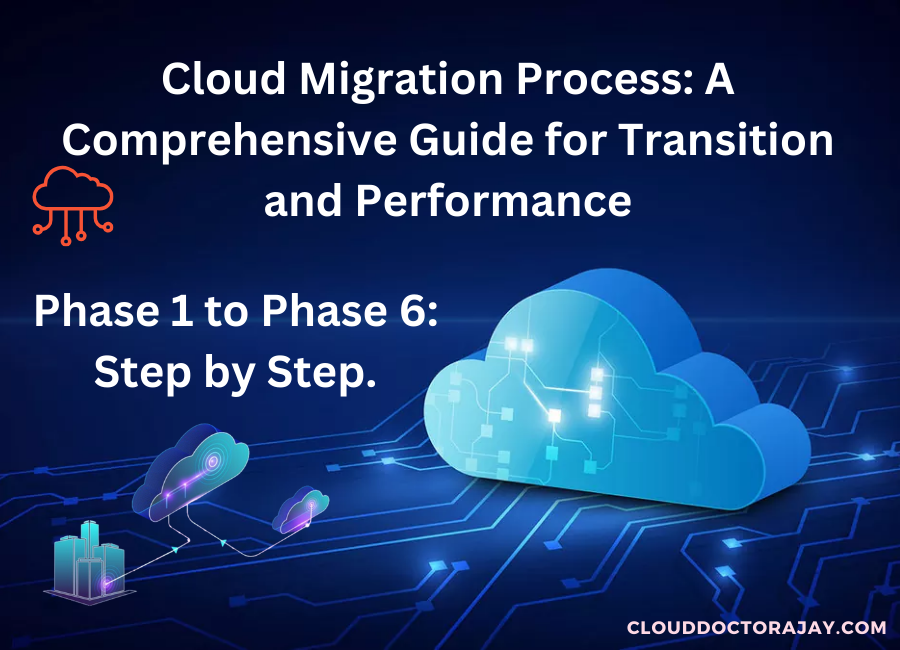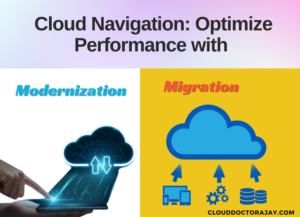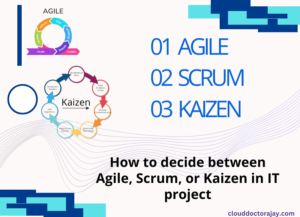Cloud Migration Process: The process of moving current systems and apps to the cloud is intricate and needs close preparation, supervision, and collaboration. This all-inclusive strategy will help you navigate the migration process:
Phase 1: Pre-Migration Planning
1. Define Goals and Objectives:
– Clearly state the aims and objectives of the company’s cloud migration.
– Establish KPIs, or key performance indicators, to gauge achievement.
2. Assessment and Inventory:
– Make a complete inventory of all currently in use systems, apps, and data.
– Analyze system dependencies and pinpoint essential parts.
3. Risk Analysis:
– Determine any possible dangers connected to the migration.
– Create mitigation plans for every risk that has been identified.
4. Choose Cloud Service Model:
– Based on your needs, select Software as a Service (SaaS), Platform as a Service (PaaS), or Infrastructure as a Service (IaaS).
5. Select a Cloud Provider:
– Compare and contrast several cloud providers according to their offerings, costs, and compliance.
– Select a supplier who understands the requirements of the firm.
Phase 2: Design and Architecture Cloud Migration
6. Architectural Design:
– Establish the desired cloud environment architecture.
– Take security, high availability, and scalability into account when designing.
7. Data Migration Strategy:
– Make a plan for moving data while taking volume, velocity, and variety into account.
– Select between a gradual approach and a one-time migration.
8. Network Architecture:
– Create a network design that will guarantee communication between cloud and on-premises settings.
– Take into account Direct Connect, VPNs, and other connectivity choices.
9. Security and Compliance:
– Create security guidelines and procedures for the cloud environment.
– Verify adherence to industry rules and specifications.
Unlocking Azure AI’s Potential for Developers: Guide to Tools and SDKs
Phase 3: Implementation Cloud Migration
10. Configuring the Environment:
– Assign the required cloud resources in accordance with the established architecture.
– Set up access controls, security groups, and networks.
11. Data Migration:
– Put the prepared data migration strategy into action.
– Check the consistency and integrity of the data after migration.
12. Application Migration:
– Transfer apps to the cloud while taking connections and dependencies into account.
– Verify the functionality of apps in the cloud environment through testing.
13. Testing:
– Carry out comprehensive testing, encompassing security, performance, and functional testing.
– Automate testing to make the process run more smoothly.
Phase 4: Verification & Validation
14. Performance Optimization:
– Make performance-related changes to the cloud environment.
– Keep an eye on resource utilization trends and make necessary adjustments.
15. User Acceptance Testing (UAT) and Validation:
– Verify that the migrated systems fulfil the necessary business requirements.
– Use end users in UAT to make sure they are satisfied.
Phase 5: Production Transition –
16. Training & Documentation:
– Give the operations team training so they can manage the cloud environment.
– Record the steps needed for further maintenance and troubleshooting.
17. Change Management:
– To handle updates and revisions, put in place a change management procedure.
– Inform pertinent parties of changes.
Phase 6: Post Migration Optimization –
18. Monitoring and Optimization:
– Use monitoring tools to keep tabs on resource utilization and performance.
– Constantly optimize resources using info from monitoring.
19. Cost Management:
– Use the cost management tools provided by cloud providers to keep an eye on and control costs.
– Use resources as efficiently as possible to save costs.
20. Continuous Enhancement:
– Create feedback channels for ongoing enhancement.
– Take lessons from the relocation process and use them into next initiatives.
Security Information and Event Management (SIEM) and Azure Sentinel: Empowering Cybersecurity
Cloud Migration Process – Conclusion:
Managing the cloud migration of current systems and apps necessitates a methodical and well-planned strategy.
For the migration process to go well and for the cloud environment to function successfully, each step should be meticulously planned, carried out, and validated. Throughout the whole migration lifetime, stakeholder participation and effective communication are essential.




